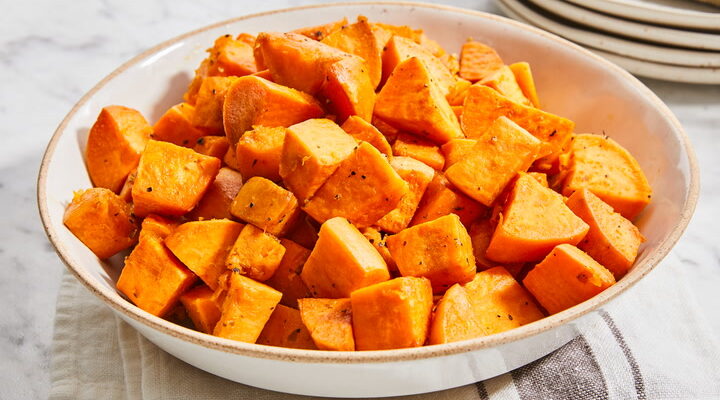Baked Camote Recipe: Camote, also known as sweet potato in many regions, is a root vegetable that’s as nourishing as it is flavorful. It’s popular in many parts of the world, especially in Filipino and Latin American cuisines. What makes camote stand out is its natural sweetness, rich orange hue, and soft texture once cooked. But aside from its delightful taste, camote packs a nutritional punch. It’s rich in complex carbohydrates, dietary fiber, vitamin A, vitamin C, potassium, and antioxidants. These nutrients make it an excellent choice for a health-conscious diet.
This humble root can be boiled, mashed, fried, or, best of all, baked. Baking camote is one of the healthiest and easiest ways to enjoy it. It retains more nutrients than boiling and offers a caramelized sweetness that frying can’t match without all the extra fat. Whether you’re looking to add a nutritious side to your dinner or a healthy snack option, baked camote is the answer.
Why You’ll Love This Baked Camote Recipe
If you’ve never tried baking camote before, you’re in for a treat. First of all, baked camote is ridiculously easy to make. You only need a handful of ingredients, and most of them are probably already in your pantry. Second, the flavor is absolutely addictive—naturally sweet with a soft interior and slightly crispy edges when done right.
This recipe is versatile. You can keep it basic and enjoy the pure flavor of baked camote, or jazz it up with spices, sweeteners, or herbs. It fits perfectly with many dietary lifestyles including vegetarian, vegan, paleo, and gluten-free diets. Need a healthy snack for kids? Camote is naturally sweet, making it an easy win. Want a comforting side dish for dinner? Pair it with grilled chicken, fish, or tofu.
And let’s not forget about meal prep! Baked camote stores well and reheats beautifully, making it a great addition to your weekly meal plan. You’ll love having it ready in the fridge for quick meals or snacks.
Ingredients You’ll Need
For the most basic baked camote, you’ll only need three simple ingredients. But there are plenty of ways to spice it up depending on your taste.
Basic Ingredients:
- 2–4 medium camote (sweet potatoes)
- 2 tablespoons olive oil (or coconut oil)
- Salt to taste
Optional Seasonings and Toppings:
- Ground cinnamon and a drizzle of honey for a sweet version
- Garlic powder, paprika, black pepper for savory
- A sprinkle of brown sugar for caramelization
- Chopped fresh herbs like rosemary or thyme
Whether you go sweet or savory, these ingredients help bring out the natural depth and flavor of camote. The olive oil not only helps crisp the edges but also carries the flavor of your chosen spices throughout.
Preparing the Camote for Baking
This is where you lay the groundwork for success. Properly prepping your camote ensures it cooks evenly and develops that soft-yet-crispy texture everyone loves.
Step 1: Clean Thoroughly
Even if you plan to peel the camote, give them a good scrub under running water. Use a vegetable brush to remove any dirt or debris. Camote grows underground and often comes coated with soil.
Step 2: Peel (Optional)
You can peel your camote or leave the skin on. The skin adds texture and extra fiber. If you prefer a smoother texture, use a vegetable peeler to remove the skin.
Step 3: Slice Evenly
Uniform slices ensure even baking. Aim for 1/4 to 1/2 inch thick slices or wedges. Too thick, and they’ll take forever to cook; too thin, and they may burn easily.
Step 4: Toss with Oil and Seasonings
In a large mixing bowl, toss your camote slices with olive oil and seasonings. This step ensures that every piece is coated evenly, which is key for flavor and texture.
Baking Instructions – Step-by-Step
Here comes the heart of the recipe. These steps will guide you to golden, caramelized, and irresistibly delicious baked camote.
Step 1: Preheat the Oven
Set your oven to 400°F (200°C). Preheating ensures the camote starts cooking right away and helps in forming a light crust on the outside.
Step 2: Arrange on a Baking Sheet
Line a baking sheet with parchment paper or a silicone mat to prevent sticking. Spread the camote slices out in a single layer. Avoid overcrowding—give them space to breathe so they roast instead of steam.
Step 3: Bake
Place the tray in the preheated oven and bake for 25 to 35 minutes, flipping halfway through. This flipping ensures even browning on both sides.
Step 4: Check for Doneness
Camote is done when the edges start to brown and crisp up, and the insides are fork-tender. The sugar content in camote helps with caramelization, giving you a slightly crisp texture and deep flavor.
Sweet vs. Savory Camote Variations
Camote’s versatility shines through in its ability to adapt to both sweet and savory preparations. Depending on your mood or the occasion, you can tailor your baked camote to satisfy your taste buds.
Sweet Variations:
For those with a sweet tooth, camote can be transformed into a delightful dessert or a comforting side dish. Here’s how:
- Cinnamon Sugar Camote: After baking, sprinkle the camote slices with a mixture of cinnamon and sugar. This simple addition enhances the natural sweetness of the camote and adds a warm, spicy note.
- Honey-Glazed Camote: Drizzle honey over the baked camote slices and return them to the oven for a few minutes. The honey caramelizes, creating a glossy, sweet coating.
- Maple Pecan Camote: Top the baked camote with chopped pecans and a drizzle of maple syrup. The nuts add a crunchy texture, while the syrup provides a rich sweetness.
Savory Variations:
If you prefer savory flavors, camote can be seasoned to complement a variety of main dishes:
- Garlic and Herb Camote: Toss the camote slices with minced garlic, rosemary, thyme, and olive oil before baking. The herbs infuse the camote with aromatic flavors, making it a perfect side for roasted meats.
- Spicy Camote Wedges: Season the camote with chili powder, paprika, and cumin for a spicy kick. Serve with a cooling yogurt dip to balance the heat.
- Cheesy Camote Bake: After baking, sprinkle grated Parmesan or cheddar cheese over the camote slices and broil until the cheese melts and turns golden brown.
Experimenting with these variations allows you to enjoy camote in multiple ways, ensuring it never becomes monotonous.
Serving Suggestions
Baked camote is incredibly versatile and can be served in numerous ways:
- As a Side Dish: Pair baked camote with grilled chicken, steak, or fish. Its natural sweetness complements savory proteins, creating a balanced meal.
- In Salads: Cube the baked camote and toss it into salads for added texture and flavor. It pairs well with leafy greens, nuts, and vinaigrettes.
- Camote Fries: Slice the camote into thin strips before baking to create healthier alternatives to traditional fries. Serve with ketchup, aioli, or your favorite dipping sauce.
- Breakfast Hash: Combine diced baked camote with sautéed onions, bell peppers, and eggs for a hearty breakfast hash.
- Camote Tacos: Use baked camote slices as a filling for vegetarian tacos. Add black beans, avocado, and salsa for a delicious meat-free option.
These serving suggestions showcase camote’s adaptability, making it a staple in various cuisines and meals.
Storage and Reheating Tips
Proper storage and reheating ensure that your baked camote retains its flavor and texture:
Storage:
- Refrigeration: Place leftover baked camote in an airtight container and store it in the refrigerator for up to 5 days.
- Freezing: For longer storage, freeze the baked camote slices on a baking sheet. Once frozen, transfer them to a freezer-safe bag or container. They can be stored for up to 3 months.
Reheating:
- Oven: Preheat the oven to 350°F (175°C). Place the camote slices on a baking sheet and heat for 10-15 minutes until warmed through.
- Microwave: Place the camote in a microwave-safe dish, cover with a damp paper towel, and heat on medium power for 1-2 minutes.
- Skillet: Reheat the camote in a skillet over medium heat, turning occasionally until heated evenly.
Avoid reheating camote multiple times, as this can lead to a loss of flavor and a mushy texture.
Common Mistakes to Avoid
To achieve the perfect baked camote, steer clear of these common pitfalls:
- Overcrowding the Baking Sheet: Placing too many camote slices on a single baking sheet can lead to uneven cooking and steaming instead of roasting. Ensure there’s enough space between slices for proper air circulation.
- Skipping the Oil: A light coating of oil helps the camote slices crisp up and prevents them from sticking to the baking sheet.
- Not Flipping the Slices: Turning the camote slices halfway through baking ensures even browning on both sides.
- Incorrect Oven Temperature: Baking at too low a temperature can result in undercooked camote, while too high a temperature may cause burning. Stick to the recommended 400°F (200°C) for optimal results.
- Neglecting Seasoning: While camote has a naturally sweet flavor, seasoning enhances its taste. Don’t forget to add salt, spices, or herbs as desired.
By avoiding these mistakes, you’ll consistently produce delicious and perfectly baked camote.
Nutritional Information
One of the standout qualities of camote is its impressive nutritional profile. Whether you’re watching your calorie intake, aiming to eat more fiber, or simply trying to get more vitamins into your diet, baked camote has you covered.
Here’s a basic nutritional breakdown per 100 grams of baked camote:
| Nutrient | Amount |
|---|---|
| Calories | 86 kcal |
| Carbohydrates | 20.1 g |
| Sugars | 4.2 g |
| Dietary Fiber | 3 g |
| Protein | 1.6 g |
| Fat | 0.1 g |
| Vitamin A | 283% RDI |
| Vitamin C | 4% RDI |
| Potassium | 337 mg |
Camote is especially rich in beta-carotene, a powerful antioxidant that converts to vitamin A in the body. This nutrient is essential for vision, immune function, and skin health. Its high fiber content aids digestion and promotes a feeling of fullness, making it a great food for weight management.
Moreover, baked camote is naturally low in fat and contains no cholesterol. Its complex carbs make it a great energy source without causing the rapid blood sugar spikes associated with simple sugars.
Customization Tips
What’s awesome about baked camote is how easily it adapts to different dietary needs and preferences. You can make small tweaks to suit various lifestyles without sacrificing taste.
Make it Vegan: Camote is naturally vegan, so just ensure any toppings or seasonings you add are plant-based. Swap out honey for maple syrup or agave nectar in sweet versions.
Make it Gluten-Free: Camote is naturally gluten-free, making it a safe option for those with gluten intolerance or celiac disease. Just be cautious with any pre-made spice mixes or sauces, as they may contain hidden gluten.
Kid-Friendly Twists: Kids love the natural sweetness of camote. Try cutting the slices into fun shapes using cookie cutters or baking them as fries. Add a small sprinkle of cinnamon and a dab of maple syrup for a nutritious treat they’ll enjoy.
Spice It Up: Want to give your baked camote a spicy kick? Add cayenne pepper, chili flakes, or even a squirt of hot sauce after baking.
Protein Boost: Pair your camote with a dollop of Greek yogurt or a sprinkling of hemp seeds to up the protein content.
With so many ways to tailor this dish, it’s no wonder baked camote is a kitchen staple in health-conscious homes.
Pairing Ideas
Baked camote’s subtle sweetness and rich texture make it a versatile companion to a wide range of dishes and drinks. Whether you’re serving a full-course meal or a quick bite, these pairing ideas can elevate your camote experience.
Main Dish Pairings:
- Grilled Chicken or Turkey: The savory, smoky flavor of grilled meats complements the sweet, soft camote beautifully.
- Salmon or Tilapia: The richness of fatty fish balances the earthy sweetness of camote.
- Tofu or Tempeh Stir-Fry: For a plant-based pairing, baked camote goes great with Asian-style tofu stir-fries.
Salad Pairings:
- Toss chunks of camote into a quinoa or kale salad with cranberries and walnuts for a nutrient-packed bowl.
- Pair with arugula, goat cheese, and a balsamic glaze for a fancier salad option.
Beverage Pairings:
- White Wine: A crisp Chardonnay or Pinot Grigio enhances the camote’s sweetness.
- Herbal Tea: Chamomile or cinnamon tea pairs well with sweet camote versions.
- Smoothies: Enjoy baked camote on the side of a green smoothie for a well-rounded snack.
These pairing suggestions not only enhance the dining experience but also help you create a balanced, flavorful meal.
FAQs about Baked Camote Recipe
1. What is baked camote?
Baked camote is a healthy and delicious Filipino snack made by baking sweet potatoes until they’re soft and caramelized. It’s naturally sweet, nutritious, and easy to prepare.
2. What type of sweet potato should I use?
You can use any variety, but the red or purple-skinned Filipino camote works best for its sweet flavor and soft texture after baking.
3. Do I need to peel the camote before baking?
Peeling is optional. Some prefer to leave the skin on for added texture and fiber, while others peel for a smoother bite.
4. How long do I bake camote in the oven?
Bake at 375°F (190°C) for about 45–60 minutes, depending on the size and thickness of the slices or whole camote.
5. Can I add toppings or seasonings?
Yes! You can sprinkle cinnamon, drizzle with honey, add butter, or even a pinch of salt for a sweet or savory twist.
6. Is baked camote good for weight loss?
Absolutely. Camote is rich in fiber and low in fat, making it a great option for a filling and healthy snack.
7. Can I bake camote ahead of time?
Yes. Store leftovers in the fridge for up to 3 days and reheat in the oven or microwave before serving.
8. Can I use an air fryer instead of an oven?
Definitely! Air fry at 375°F (190°C) for 25–30 minutes, checking for doneness halfway through.
9. Is baked camote suitable for kids?
Yes, kids love its natural sweetness. It’s a healthy snack option packed with vitamins and minerals.
10. What are the health benefits of camote?
Camote is high in vitamin A, fiber, and antioxidants. It supports eye health, digestion, and boosts energy.
Conclusion
Baked camote is one of those rare dishes that hits every mark—it’s easy to make, insanely delicious, highly nutritious, and endlessly versatile. Whether you go sweet or savory, serve it as a snack or a side, or make it kid-friendly or gourmet, you’ll always end up with something satisfying and healthy. Now that you’ve got this comprehensive step-by-step guide, there’s no reason not to bake some camote today.
So preheat that oven, grab your spices, and get ready to fall in love with one of the most underappreciated superfoods out there. Your taste buds—and your body—will thank you.



